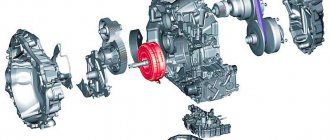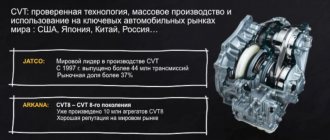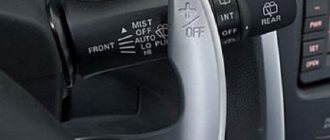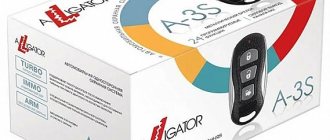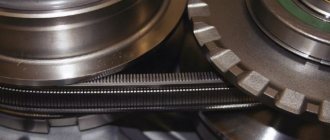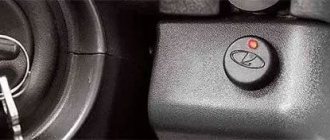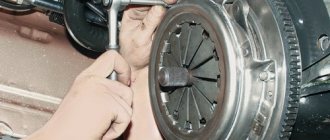In the article we will look at the schematic structure of a variator, the principle of operation, we will analyze the pros and cons of variator boxes and touch on the issue of how to service a variator, how to drive a car with a variator correctly, and what not to do.
What is a variator
A variator or CVT box (continuously variable transmission) is a type of automatic transmission that transmits torque from the engine to the wheels at constant engine speed. The CVT transmission is unique in that it is continuously variable: it allows you to change speeds not in steps, but very smoothly, gradually increasing or decreasing the gear ratio as the car accelerates or decelerates.
The CVT allows you to change gears in different ways:
- automatically,
- manually,
- according to a given program.
CVT device
Let's look at the schematic design of a CVT box.
The CVT transmission consists of:
- devices for asynchronizing the engine and gearbox (used when starting off);
- Samgo variator;
- devices for providing reverse (usually a gearbox);
- electronic control unit;
- hydraulic pump.
Misconception 2. The variator has a belt
Most designs actually use a belt made up of a large number of steel plates held in place by a belt. But some manufacturers prefer to use a chain. It looks almost the same as an engine timing chain. Only contacts the cones. Torque is transmitted by the ends of the rods connecting the plates. Such a variator is called a chain variator. Chain CVTs are used, for example, by Subaru and Audi.
The Subarov variator uses a chain drive. This design can withstand more torque than the belt can transmit.
The Subarov variator uses a chain drive. This design can withstand more torque than the belt can transmit.
Types of variators
There are several types of CVT gearboxes:
- V-belt,
- toroidal,
- chain
Let's consider the device of the first two, which are the most popular.
V-belt variator
This is the most common type of CVT gearbox. A V-belt variator consists of two pulleys (driver and driven), connected to each other by a metal V-belt.
Each pulley consists of two cone-shaped disks with sharp ends facing each other. These cones can move towards each other and back. As the cones move relative to each other, the diameter of the pulley changes smoothly, which leads to an increase or decrease in the friction force when the belt moves and a change in the radius of the belt bending around the pulleys, and thus to a smooth change in the gear ratio.
The diameter of the pulleys is synchronously adjusted by the electronic control module depending on the operation of the power unit.
The belt in the V-belt box rotates only in one direction, which ensures that the car moves only forward. For driving in reverse, a gear device is provided, which is responsible for changing the direction of rotation of the output shaft.
The belt in a V-belt variator has a complex structure and is a composite metal belt consisting of smaller steel belts with a complex cross-section. On these belts there are a large number of thin transverse metal plates of a trapezoidal shape, whose edges face the pulley. This structure allows you to maintain the rigidity of the belt at any time and throughout its length.
To lubricate the belt, a special liquid is used, which changes its phase state under the influence of increasing pressure at the point of contact with the pulley. This allows the steel belt to maintain adhesion to the pulley without slipping, despite the extremely small contact area.
Toroidal variator
It consists of two wedge-shaped disks, with their narrow ends directed toward each other. The disk coming from the engine is the driving disk, the disk directed to the cardan is the driven disk. Between these disks there are rollers that rotate around their axes and move from one disk to another.
Torque is transmitted due to the friction force that occurs between the surfaces of the disks and rollers. The position of the rollers determines the gear ratio in the variator. Nowadays, toroid boxes are practically not used in car assembly due to their complex technology and low reliability, giving way to more practical V-belt boxes.
Technical elements of V-belt CVT
The elements of a V-belt variator include:
CVT design
- clutch, which is responsible for connecting the engine with the transmission;
- torque converter;
- tapered pulleys;
- connecting chain (belt);
- an oil pump that creates the required pressure (in some cases, the operation of the cone elements is provided by hydraulics or a spring);
- a hydraulic unit that supplies oil to various parts of the drive and driven shafts;
- filters;
- radiators that take heat from the box;
- control system connected to the car's ECU;
- reverse device.
Advantages and disadvantages of a variator
CVT transmissions are practically not installed on trucks due to increased engine loads.
A CVT transmission has its pros and cons, which you need to know before buying a car with a CVT.
Advantages of a CVT
- Provides very smooth acceleration, driving and braking.
- There is no slowdown on long climbs.
- Provides more economical fuel consumption than a classic automatic transmission.
- The variator provides very low noise and vibration levels when the engine is running.
- Provides quick response when selecting the optimal gear ratio.
- Eliminates critical load on the engine.
- The variator eliminates slipping of the drive wheels.
- It has a simpler design than a classic gearbox.
Disadvantages of a CVT
- It is advisable not to overheat the variator at maximum engine speeds, getting carried away by driving “gas pedal to the floor”, or by prolonged slipping in one place. This can lead to rapid wear of the cone discs and belt.
- The operation of the variator is controlled by several control sensors; failure of any of them will require expensive repairs.
- A CVT transmission requires periodic transmission oil changes, more often than in a classic box. And the cost of oil for a variator is higher than for an automatic transmission.
- Every 100-120 thousand mileage you need to change the variator belt.
- Repairing a CVT transmission is very expensive and it is often cheaper to replace the CVT with a new one than to repair the old one.
How does a variator differ from an automatic?
Externally, a car with a CVT and a classic automatic are no different. The CVT transmission has the same operating modes as the automatic. Differences begin to be felt only while driving.
When accelerating, the car does not make characteristic sounds coming from increasing engine speed. The sound of the running engine practically does not change while driving, despite braking and rapid acceleration. For a driver without experience driving a car with a CVT, this is very confusing. At the same time, there is a feeling that the car seems to be “stupid”, responds poorly to pressing the gas pedal, and during rapid acceleration something is strongly holding the car back. But these feelings are deceiving. A car with a CVT accelerates the same as a car with an automatic transmission.
This unusual response is due to the fact that the variator does not have so-called gear stages; in fact, there is only one. The gear ratio increases and decreases absolutely smoothly. During acceleration, the engine operates as efficiently as possible: the speed corresponds to the speed of the car at the current moment. This leads to a feeling of the engine "freezing".
With a stepped transmission, during acceleration, the engine speed increases, followed by a transition to a higher gear stage. A car with a CVT allows the engine to operate at the same speed by smoothly changing the gear ratio.
To make CVTs more “familiar”, some manufacturers use the effect of increasing engine noise according to an increase in vehicle speed.
When driving at a constant speed, the variator selects the most efficient gear ratio, which consumes a minimum of fuel. Therefore, cars with a CVT are very economical.
The efficiency of the variator during acceleration is replaced by inefficiency during braking, since the variator selects the optimal gear ratio, but at the same time engine braking is turned off, at which it is desirable to reduce the gear ratio.
Misconception 7. The CVT has no steps
Yes and no at the same time. This postulate is refuted by gearboxes that have both a belt variator and a two-stage gearbox. Our car enthusiasts first saw it on the Nissan Juke, and now it has reached the Lada Vesta. It is produced by Jatco (Japan), index - JF015E. The bottom line is that the variator provides approximately half of the entire speed range in first gear, and then, when moving to second, it again realizes its range. Thus, in the classical sense, this variator has two gears. But most transmissions like this are also trained to simulate five or six gears electronically. These programs are, of course, “not real”, virtual.
Toyota's newest Direct Shift-CVT uses gear first gear and then engages a belt with cones.
Toyota's newest Direct Shift-CVT uses gear first gear and then engages a belt with cones.
Is it worth buying a car with a CVT?
To make a decision, you must drive such a car and feel how it picks up speed, how it slows down, and what kind of engine noise it makes.
If you like a relaxed, quiet ride on relatively good roads, then the CVT will meet your expectations.
If you plan to frequently drive off-road and like to enjoy fast acceleration and high speed, it is most likely better to opt for a manual or automatic transmission.
A zero or very low (up to 50,000 km) mileage of the car will speak in favor of the variator. If the car has a high mileage, then it may have problems with the variator, which will require expensive repairs.
Basic service life for common modern brands
— Nissan X-Trail. On average, major repairs are required after 100 thousand kilometers. It is associated with wear and tear on the chain, which stretches over time. No abrasion of the pulley surfaces to a level requiring replacement was observed.
— Nissan Qashqai. The manufacturer estimates the mileage to be 100-150 thousand km, which will need to be completed before replacing the belt. However, it is noted that endurance depends on the frugality of the owner and general driving style.
— Mitsubishi Outlander. The manufacturer provides a guarantee of 200 thousand km. Judging by the reviews of the owners, this period is justified, although there is a particular sensitivity to broken roads. As a result of vibrations, the belt fails much faster.
— Nissan Teana. Considering the powerful engine of 2.5 liters and with solid torque, the CVT is more of an option to please drivers than a technical necessity. The official warranty is 170,000 km. Car owners complain that the continuously variable transmission of this car does not last even 100 thousand.
— Nissan Juke. The Japanese manufacturer Jatco gives it a 100,000 km guarantee. The main mistake Juke owners make is that they use it with a heavy load. For example, to remove crops from a dacha. One flaw in the box is the weld around the planetary gear sun gear. A misalignment occurs at the attachment point when it diverges, which cuts off the teeth of the sun gear.
— Toyota RAV4. V-belt variators Aisin or Multitronic can travel up to 100 thousand km on this machine. with respect. Usually owners make a big mistake - they try to test this car in absolute off-road conditions.
How to drive a car with a CVT correctly
Driving a car with a CVT is generally similar to driving a car with a classic automatic transmission. But, a car with a CVT is more sensitive to overheating and overloads, therefore, in order to extend the life of the CVT, you must strictly follow the rules for handling the CVT.
- You need to move away very smoothly; when you try to start abruptly, the belt slips in the variator, which, if repeated frequently, will cause the belt to break.
- When starting from a stop in Drive mode, you should not press the brake and gas pedals at the same time, as this leads to rapid heating of the transmission oil. Sometimes this is done in cars with automatic transmission to make the start more abrupt. In a car with a variator, this principle does not work and only leads to wear and tear on the gearbox.
- On a car with a CVT, it is better to prevent wheel slipping both when starting off and while driving. Such slippage can occur in winter, when the road surface is covered with snow and ice. If you press the gas pedal excessively, slipping can start abruptly and stop abruptly, which will lead to shock loads in the box and significant belt slipping. It is better to start the car slowly and with tension. For the same reason, it is better not to let the car slip for a long time in one place.
- In a car with a CVT, it is better to avoid bad dirt roads where you will have to skid. Any such load leads to overload of the transmission, since excess torque from the engine immediately goes into slipping of the variator belt.
- A car with a CVT cannot tow another car. Trying to pull out another car stuck in the mud can have a particularly detrimental effect on the variator.
- While driving, it is better not to put the switch in position N (neutral). This will not lead to fuel savings, but it will negatively affect the CVT.
- During a short stop (for example, at a traffic light), it is better to turn on the N (neutral) or P (Parking) position. The variator has a fairly simple structure compared to an “automatic” and “robot”, so during short stops it is better to disconnect the mechanical voltage from the engine to the variator. In “automatic” and “robot” it is better not to do this, so as not to switch their complex mechanisms once again.
Service life of the box - automatic
Let's start right away with the fact that if previously the service life of an automatic transmission was noticeably different from a manual transmission, today the difference is no longer so obvious. On the one hand, the machines themselves have become much more technologically advanced, and on the other hand, over the last 20 years, manufacturers have been consciously putting a certain resource into each unit at the design stage.
In other words, the legendary “indestructible” gearboxes (both manual and automatic transmissions) and so-called million-dollar engines are no longer produced. If earlier manual transmissions on many foreign cars lasted for 300-350 thousand or more without problems, today the mechanics have now become less reliable.
This happened due to savings on materials, as well as as a result of the emergence of more powerful and efficient internal combustion engines, which forces the transmission to constantly work in loaded modes.
As practice shows, today the average service life indicators for automatic transmissions are almost equal to similar indicators for manual transmissions. The only thing is that in manual transmissions, it is often not the gearbox itself that causes problems, but individual components (for example, the clutch). At the same time, mechanics are still cheaper and easier to repair, and they also fail prematurely much less often.
- Let's move on. With the manual transmission and the question of how long a manual transmission lasts, we sorted it out a little. Now let's get back to the machines and their reliability. Given such a variety of automatic transmissions, it would simply be incorrect to say unequivocally that all automatic transmissions are unreliable. In fact, it all depends on the type of unit, as well as on the individual characteristics of operation and quality of service.
So, although all automatic transmissions have the same purpose, among the main types of automatic transmissions we can distinguish automatic, variator and robot. Please note that all these types of boxes differ significantly from each other in design and operating principles. At the same time, we note once again that the resource of one box may differ markedly from another, even within the same group. Let's figure it out.
How to properly maintain a variator
The operation of the variator, with proper operation of the car, is designed for a very long time, since there is practically nothing to break in a V-belt variator. To maintain the normal operation of the CVT box, it is necessary to carry out periodic maintenance.
- It is advisable to change the transmission oil in the variator every 40-50 thousand mileage. If the intervals between oil changes are much longer, then as a result of the contact of the belt with the discs, tiny metal shavings will accumulate, which will lead to accelerated wear of the internal parts of the variator.
- CVT oil should only be purchased original and from official dealers who guarantee the quality of the purchased product. It is better not to mix oil from different manufacturers in the CVT box. You should also fill in oil of the same viscosity.
- It is better to change the oil in the variator in the traditional way. Express replacement under pressure does not remove metal shavings and wear debris, and they are only worse distributed throughout the variator.
- When changing the oil, you need to remove the pan and clean the magnets that catch wear products, as well as the hydraulic system valves.
- You also need to replace the coarse and fine filters and old gaskets to prevent oil leaks from the variator. Lack of oil in the box will lead to damage to the variator.
- Periodically you need to check the variator cooling system to prevent the box from overheating.
- In V-belt boxes, it is recommended to change the belt every 100-120 thousand kilometers, even if there are no visible belt defects.
Basic tips for owners of a car with a CVT
- The driving style of a car with a CVT should be smooth and calm, excluding extreme loads.
- Follow the CVT control instructions exactly, do not press two pedals at the same time.
- Carry out CVT maintenance according to the manufacturer's recommendations. Many experienced drivers recommend doing this twice as often.
- Buy only original consumables from authorized dealers.
- The transmission oil poured into the variator must have a viscosity level appropriate for the climate where you live.
- Do not mix different gear oils, especially those with different viscosity levels.
- When changing the oil, clean the magnets from wear products and check the serviceability of the box cooling system.
- It is better to entrust the maintenance, diagnostics and repair of CVTs to certified centers that have a good reputation.
